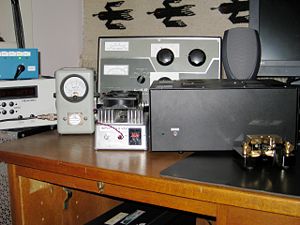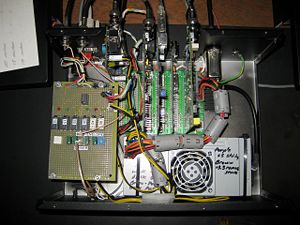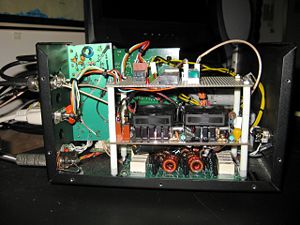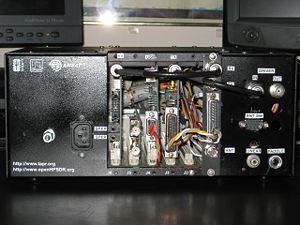Difference between revisions of "A Basic HPSDR Transceiver in PANDORA"
m (Author provided revised text.) |
|||
| (2 intermediate revisions by one other user not shown) | |||
| Line 1: | Line 1: | ||
| − | A | + | A Basic HPSDR Transceiver in PANDORA by John Petrich, W7FU |
This series of photos illustrates a basic HPSDR transceiver installation in a Pandora enclosure. The underlying philosophy for this particular rig is to package the core HPSDR components in a manner that permits easy and flexible interface to both evolving core components and existing or evolving station accessories. The result of this approach is an economical and flexible rig that permits experimentation and development. This rig does not offer the refinement of a “complete” station, but rather is the HPSDR nucleus of an experimenter’s station. | This series of photos illustrates a basic HPSDR transceiver installation in a Pandora enclosure. The underlying philosophy for this particular rig is to package the core HPSDR components in a manner that permits easy and flexible interface to both evolving core components and existing or evolving station accessories. The result of this approach is an economical and flexible rig that permits experimentation and development. This rig does not offer the refinement of a “complete” station, but rather is the HPSDR nucleus of an experimenter’s station. | ||
| Line 17: | Line 17: | ||
John Petrich, W7FU | John Petrich, W7FU | ||
| + | |||
| + | [[Category:Hardware available]] | ||
Latest revision as of 10:04, 11 April 2011
A Basic HPSDR Transceiver in PANDORA by John Petrich, W7FU
This series of photos illustrates a basic HPSDR transceiver installation in a Pandora enclosure. The underlying philosophy for this particular rig is to package the core HPSDR components in a manner that permits easy and flexible interface to both evolving core components and existing or evolving station accessories. The result of this approach is an economical and flexible rig that permits experimentation and development. This rig does not offer the refinement of a “complete” station, but rather is the HPSDR nucleus of an experimenter’s station.
Pandora is a quality product with excellent fit and finish. The enclosure offers sufficient space for adequate cooling of components and easily accommodates the necessary elements of a basic HPSDR rig with minimal metal working. Additional core elements can be accommodated with careful space planning. A variety of examples for assembly mounting and interconnection of circuit modules are illustrated.
The first photo depicts the philosophy of the basic HPSDR station that can use common existing station accessories: the Pandora enclosure containing the basic HPSDR rig, medium and high power PA’s, a commercial SWR and power meter, and an antenna select switch.
The second photo is a view from above into the open Pandora enclosure. This photo depicts the integration of core rig components. At the top, in the 12:00 o’clock position, is the HPSDR core for a basic station: the Atlas board on which are mounted the Mercury receiver, Penelope transmitter, Magister interface and the Excalibur temperature compensated oscillator. Not easily visible is the NT Electronics T-R switch board on the left edge of the HPSDR core. The Atlas board is securely mounted to the six threaded pillars that come built into the floor of Pandora. Viewing clockwise is the filtered 110 VAC receptacle, and ground stud mounted on the rear panel. Continuing clockwise to the 6:00 o’clock position, behind the front panel, is an economical 210W ATX switching power supply. The power supply is mounted with plastic cable wraps routed through holes drilled in the floor of the enclosure. Continuing to the left side of the enclosure is the top view of a stack of PC boards on which are built the 100W band switched LPF assembly, a 1 to 20W low distortion linear amplifier, and the antenna selection interface and band switched variable attenuator assemblies. These PC boards are stacked on four “all thread” studs rising from the floor of Pandora and separated vertically by plastic spacers. Close inspection will show that interconnects between boards and assemblies are either by BNC coaxial connections or by standard .100 header connectors and home made wire bundles.
The third photo is a side view of the PC stack. The threaded studs with the plastic spacers, header connectors and wire bundles are visible in profile. The PC board nearest the floor of Pandora is the band switched LPF assembly, a modified K5OOR LPF-100 kit. In the middle of the stack is mounted a modified Motorola AN-779 driver amplifier obtained from Communication Concepts Inc. Note the small cooling fans attached to each heatsink of the driver. The top PC board of the stack is a Vector board that supports the combined band switched antenna selection interface and the band switched adjustable output attenuator for Penelope. Driving all the band switched assemblies are the open collector outputs available at the DB25 connector on Penelope. Also visible is the antenna selection connector cable that runs from the rear of this PC board to the DB9 connector on the rear panel.
The last photo illustrates the interfaces exiting the rear panel of Pandora. On the far left is the AC power receptacle and ground stud. In the center is the familiar HPSDR core assemblage of connectors. On the extreme right edge of the HPSDR core is the NT Electronics T-R board oriented with the antenna BNC as the bottom BNC connector. At the far right, and nearest the top of the rear panel, are the input and output BNC RF connectors for the driver board. In the middle, the DB9 connector links the internal band switched antenna selection interface to the remote antenna selector switch. On the bottom row, the quarter inch CW paddle jack is on the far right. Slightly to the left of this jack, is located the RCA jack that connects an open collector output available from Penelope to the remote amplifier(s) for PTT control.
Clearly there is considerable physical space remaining in Pandora for additional assemblies. The unused space above the AC input receptacle and PS and the front panel are underutilized. The PS has ample reserve to power additional low level circuitry.
John Petrich, W7FU



